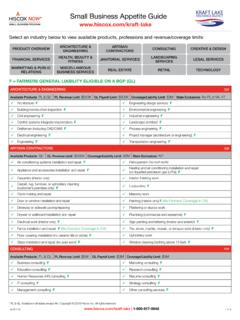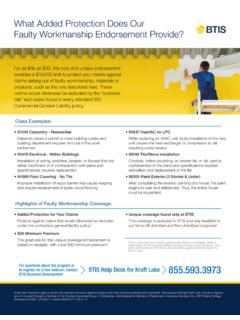Transcription of LONG-TERM CHLORIDE PENETRATION RESISTANCE OF SILICA …
1 LONG-TERM CHLORIDE PENETRATION RESISTANCE OF SILICA . FUME CONCRETES BASED ON FIELD EXPOSURE. Hooton (1), E. Bentz (1), and T. Kojundic (2). (1) Dept. of Civil Engineering, University of Toronto, Toronto, Canada, M5S 1A4. (2) Elkem Materials, Pittsburgh PA USA (and Director, SILICA Fume Association). Abstract With support from the SILICA Fume Association in the United States, cores were obtained in 2001 and 2002 from four concretes from bridge decks in New York State and one in Ohio. In addition, cores were taken from 4 parking garage decks located in Wisconsin, Utah, and 2 in Ohio. All concrete structures were between 6 and 15 years old when cored and which had been exposed to de-icing salts. The cores were tested for CHLORIDE PENETRATION profiles using mm profiling, CHLORIDE bulk diffusion by ASTM C 1556 (similar to Nordtest NT Build 443), rapid CHLORIDE PENETRATION (ASTM C 1202), and the depth of cover was noted, where visible.
2 The results show that all of the SILICA fume concrete decks had high RESISTANCE to CHLORIDE PENETRATION , with all full depth bridge decks having between 290 and 690 coulombs on average, while the portland cement concrete had 3900 coulombs. For parking decks, coulomb values ranged from 620 to 980. Predicted time-to-corrosion service life, using the Life-365 program, gave residual life estimates of between 30 and 61 years for the SILICA fume concretes. In one case, portland cement concrete in an approach slab to a bridge deck was used as a control and was found to be likely subject to corrosion at the time of coring. Predicted residual service lives based on extrapolation from existing CHLORIDE PENETRATION profiles gave longer estimates by 10-years on average for the 3 new bridges and for allof the parking garage decks made with SILICA fume concrete.
3 1. INTRODUCTION. Due to premature corrosion of reinforcement due to ingress of deicer salts, highway agencies have taken a number of measures to improve durability and obtain longer service lives in bridge structures. One of these measures has been to reduce the rates of CHLORIDE PENETRATION by use of concretes with lower water to cementitious materials ratios and through use of supplementary cementing materials, such as SILICA fume. These measures have been shown to be effective, for example by Hooton et al [1] in laboratory tests, but there has not been much evaluation of long- term field performance. To address this, evaluation of field-exposed SILICA fume concretes is the topic of this contribution. 2. TEST PROGRAM. In 2001-2002, multiple cores were obtained from 5 bridge decks and 4 parking garage decks between 6 and 15 years old in New York State, Ohio, Utah, and Wisconsin as listed in Table 1.
4 The Ohio bridge deck was 15 years old and made with SILICA fume concrete (477kg/m3. cementitious materials with SILICA fume, w/cm) as previously described by Bunke [2]. The New York bridges included a 6 year old Portland cement concrete ( w/c, 400kg/m3), a 6. year old, concrete with 20% F-fly ash and 6% SILICA fume (400kg/m3), a 7 year old, 11%. SILICA fume, concrete (455kg/m3), and a 12 year old SILICA fume concrete overlay (6% SILICA fume, , 400kg/m3). The New York Route 78 bridge deck concrete has been detailed by Streeter [3]. The General Mitchell Airport parking deck was a 12 year old, w/cm concrete (335kg/m3) with Class C fly ash, and SILICA fume [4]. Cincinnati's Children's Hospital garage concrete was a 14 year old ( w/cm, 390kg/m3, 10% SILICA fume) concrete when cored. The Columbus Capitol South parking garage was a 12 year old structure when cored (363kg/m3 cement, and SILICA fume).
5 The Salt Lake City Airport parking garage was a 14 year old garage when sampled (cement 363kg/m3, 15% Class F fly ash, and SILICA fume). Table 1: Location of Structures, and Concrete Mixture Information Year CM SF Fly Ash Location Project Code W/CM. Placed (kg/m3) 3. (kg/m ) (kg/m3). Ohio Bridge #161-0151 DOT 1987 417 60 0. Overlay I-90. New York KR 1988 405 50 0. over Kraft Road New York Rt. 78 Class HP 78 1994 297 24 59. Rt. 96 Class H- ref mix, New York FB-H 1996 400 0 0. approaches Rt. 96 Fall Brook Class FB- New York 1996 297 24 59. HP HP. Salt Lake Airport Utah SL 1989 363 25 54. Garage Children's Hospital Ohio CH 1990 390 39 0. Garage Capital South COTA. Ohio CS 1986 363 27 0. Garage General Mitchell 59. Wisconsin GM 1989 335 23. Airport Garage (Type C). Cores were also obtained form five parking structures, but results are not included here.
6 Cores were visually examined, catalogued, and then cut for various tests to determine depth of carbonation and CHLORIDE PENETRATION . Standard CHLORIDE RESISTANCE properties were also measured. Slices from cores were tested for electrical conductance which integrated over a 6 hour test period (rapid CHLORIDE permeability) using ASTM C1202 (AASHTO T277), with results expressed in coulombs. Some core slices were tested using ASTM C1556, CHLORIDE Bulk Diffusion. Samples were saturated and stored in lime water for one week, prior to being immersed in NaCl solution at 23oC for 40 days. The samples were then profile ground, using a milling machine fitted with a 50mm diameter diamond core bit, to obtain samples at approximately each mm of depth. The powder samples were then digested in acid as per ASTM C1152, filtered, and CHLORIDE analysis was performed using a Metrohm Titrino autotitrator.
7 Surface CHLORIDE and bulk diffusion values were then fitted using Tablecurve software using a numeric solution to Fick's 2nd law [3]. To determine the CHLORIDE PENETRATION in service, the top 50mm slices of selected cores were profile ground using a milling machine fitted with a 50mm diamond bit. Powder samples were taken at approximately each mm of depth and every other sample was digested in nitric acid, filtered, and then titrated using the potentiometric titrator. 3. RESULTS. Depths of carbonation, as determined by phenolphthalein indicator, were zero in all but one case. For the Route 78 bridge cores, carbonation was ASTM C1202 results are shown in Table 2. Bulk CHLORIDE diffusion results are shown in Table 3. Table 2: ASTM C1202 RESISTANCE to CHLORIDE Ion PENETRATION Results Average Charge CHLORIDE Ion SFC Project Cores Code Test 1 Test 2 Test 3.
8 (coulombs) Penetrability General Mitchell Airport Parking, GM 775 978 877 Very Low Milwaukee Children's Hospital 3674 1711 Low CH 721 728. Parking, Cincinnati (CH-3) (725 w/o CH-3) (Very Low). Capitol South (COTA. CS 938 979 959 Very Low Garage), Columbus Ohio DOT Bridge #. DOT 1061 323 692 Very Low 161-0151. NY DOT, I-90 over KR 1900 2819 2359 Moderate Kraft Road NY DOT, Rt 78 78 333 252 293 Very Low NY DOT, Rt 96 over FB:1,4,5,8 4714 308 3899 Moderate Fall Brook, Class H. NY DOT, Rt 96 over FB:2,3,6,7 553 304 428 Very Low Fall Brook, Class HP. Salt Lake City Airport 3032 1481 Low SL 787 623. Garage (SL-5) (705 w/o SL-5) (Very Low). The non- SILICA fume, FB-Class H concrete had bulk diffusion coefficients about 10 times higher than the SILICA fume decks and a much average higher coulomb values as well. The Kraft Bridge (KR) SILICA fume overlay, which was the first trial of this type of concrete in New York State, was not as CHLORIDE resistant as the later SILICA fume decks, as measured by bulk diffusion or by coulombs.
9 Table 3: CHLORIDE Bulk Diffusion Test Results CHLORIDE Concentration Diffusion SFC Project Cores Core ID Coefficient (10-12. Surface (%) Background (%) m2/s). General Mitchell GM-2 Airport Parking, Milwaukee GM-4 CH-2 Children's Hospital CH-4 Parking, Cincinnati CH-6 Capitol South (COTA CS-2 Garage), Columbus CS-4 Ohio DOT Bridge # DOT-1 161-0151 DOT-3 NY DOT, I-90 over KR-1 Kraft Road KR-3 78-2 NY DOT, Rt 78. 78-4 NY DOT, Rt 96 over FB-1 (class H) Fall Brook, Class H FB-4 (class H) NY DOT, Rt 96 over FB-3 (class HP) Fall Brook, Class HP FB-6 (class HP) SL-2 Salt Lake City Airport SL-4 Garage SL-6 * * *. * results do not appear to be valid A set of surface CHLORIDE PENETRATION curves for 6-year exposed NY Fall Brook Class HP deck are shown in Figure 1. Depths of reinforcement, where encountered in the various cores, were between 60 and 85mm.
10 Two different pseudo-diffusion coefficients were fitted to the surface CHLORIDE profiles based on either the total time of service, or the time of service over which deicers were likely applied (based on weather records and first and last days of freezing temperatures). These are shown in Table 4. The sets of calculated diffusion values are considered to approximately represent the upper and lower bound estimates of the actual in-situ effective diffusion coefficients. While CHLORIDE de-icers are only applied for part of the year, exposure to rain will both wash near- Table 4: Diffusion Values based on In-service CHLORIDE PENETRATION CHLORIDE Concentration (% by Diffusion Coefficient Core mass of concrete) (m2/s). Core Information ID Surface Surface Background Total Winter (Total) (Winter). GM-1 General Mitchell Airport GM-2 Parking Milwaukee GM-3 Constructed: GM-4 Sept 1989-August 1990.





